-
 Bitcoin
Bitcoin $83,443.6737
-1.76% -
 Ethereum
Ethereum $1,825.6264
-3.20% -
 Tether USDt
Tether USDt $0.9997
-0.02% -
 XRP
XRP $2.0597
-2.32% -
 BNB
BNB $597.9023
-1.48% -
 Solana
Solana $119.3459
-5.03% -
 USDC
USDC $0.9999
-0.01% -
 Dogecoin
Dogecoin $0.1660
-3.39% -
 Cardano
Cardano $0.6523
-3.11% -
 TRON
TRON $0.2359
-1.14% -
 Toncoin
Toncoin $3.8299
-5.08% -
 UNUS SED LEO
UNUS SED LEO $9.3665
0.55% -
 Chainlink
Chainlink $13.1586
-4.88% -
 Stellar
Stellar $0.2618
-2.77% -
 Sui
Sui $2.3705
0.07% -
 Avalanche
Avalanche $18.4778
-4.84% -
 Shiba Inu
Shiba Inu $0.0...01228
-1.59% -
 Hedera
Hedera $0.1637
-2.32% -
 Polkadot
Polkadot $4.0481
-1.61% -
 Litecoin
Litecoin $83.0708
-0.33% -
 MANTRA
MANTRA $6.3449
1.40% -
 Bitcoin Cash
Bitcoin Cash $299.2669
-2.15% -
 Bitget Token
Bitget Token $4.5420
-2.09% -
 Dai
Dai $0.9999
0.00% -
 Ethena USDe
Ethena USDe $0.9999
0.02% -
 Pi
Pi $0.6659
-4.49% -
 Hyperliquid
Hyperliquid $12.4532
-5.21% -
 Monero
Monero $215.7704
-0.13% -
 Uniswap
Uniswap $5.9598
-3.90% -
 Aptos
Aptos $5.2030
-1.76%
Does staking mining require specific hardware equipment?
Staking mining secures crypto networks without needing specialized hardware like ASICs or GPUs, making it more accessible and energy-efficient than traditional mining.
Apr 02, 2025 at 08:21 am
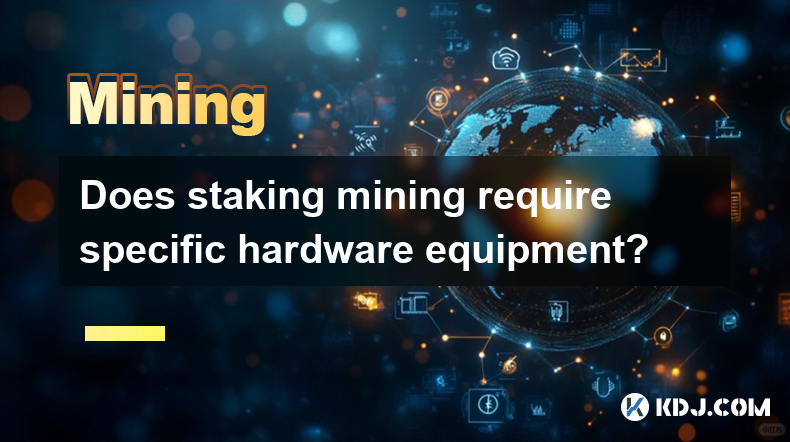
Staking mining, often referred to simply as staking, is a process used by various cryptocurrencies to secure their networks and validate transactions. Unlike traditional mining, which often requires specialized hardware like ASICs (Application-Specific Integrated Circuits) or high-performance GPUs (Graphics Processing Units), staking typically does not require such specific hardware equipment. Instead, staking primarily relies on holding a certain amount of cryptocurrency in a wallet to participate in the network's consensus mechanism. This article will explore whether staking mining requires specific hardware equipment, detailing the necessary components and comparing it to traditional mining.
What is Staking Mining?
Staking mining is a method used by proof-of-stake (PoS) and delegated proof-of-stake (DPoS) cryptocurrencies to validate transactions and create new blocks. In this system, participants, or "stakers," lock up a portion of their cryptocurrency holdings as a stake. This stake acts as collateral, and in return, stakers are chosen to validate transactions and add them to the blockchain. The probability of being chosen to validate a block is often proportional to the amount of cryptocurrency staked.
Hardware Requirements for Staking
Staking does not require the specialized hardware that traditional mining does. Here are the typical hardware requirements for staking:
- A computer or laptop: Any modern computer or laptop with a stable internet connection can be used for staking. The processing power required is minimal compared to mining.
- A cryptocurrency wallet: This can be a software wallet installed on your computer or a hardware wallet. The wallet must support the cryptocurrency you wish to stake and be compatible with staking.
- Stable internet connection: A reliable internet connection is crucial for maintaining your stake and participating in the validation process.
Comparison with Traditional Mining
Traditional mining, particularly for cryptocurrencies like Bitcoin, requires significant hardware investment. Here are the key differences in hardware requirements between staking and traditional mining:
- ASICs and GPUs: Traditional mining often requires ASICs or GPUs, which are designed to perform the complex calculations needed to solve cryptographic puzzles. These devices can be expensive and consume a lot of electricity.
- Cooling systems: Due to the high heat output of mining hardware, cooling systems are often necessary to prevent overheating and maintain performance.
- Power supply: Mining rigs require robust power supplies to handle the high energy demands of the hardware.
In contrast, staking does not require these specialized components. The hardware used for staking is generally more accessible and less costly, making it a more inclusive option for participants.
Types of Staking and Their Hardware Needs
There are different types of staking, each with slightly varying hardware requirements:
- Solo Staking: This involves running your own node to participate in the staking process. You'll need a computer or server with enough storage and processing power to run the blockchain's software. However, the hardware requirements are still far less demanding than those for mining.
- Pool Staking: Joining a staking pool allows you to combine your stake with others to increase the chances of being selected to validate a block. The hardware requirements are similar to solo staking but may be less demanding since the pool's infrastructure handles much of the workload.
- Delegated Staking: In this method, you delegate your stake to a validator who runs the necessary hardware. Your role is simply to hold the cryptocurrency in a compatible wallet, requiring minimal hardware on your end.
Software Requirements for Staking
While the hardware requirements for staking are minimal, the software aspect is crucial. Here are the key software components needed for staking:
- Blockchain software: You'll need to download and run the blockchain's software, which manages the staking process. This software can be resource-intensive but is still within the capabilities of most modern computers.
- Staking wallet: A wallet that supports staking is essential. Some wallets are integrated with the blockchain software, while others are standalone applications.
- Node software: For solo staking, you'll need to run a full node, which requires more storage and processing power than a light node but is still manageable with standard hardware.
Benefits of Staking Over Traditional Mining
Staking offers several advantages over traditional mining, particularly in terms of hardware requirements:
- Lower entry barrier: The minimal hardware requirements make staking more accessible to a broader audience. You don't need to invest in expensive mining rigs to participate.
- Energy efficiency: Staking consumes significantly less energy than traditional mining, making it a more environmentally friendly option.
- Reduced maintenance: With less complex hardware, there's less need for maintenance and cooling systems, reducing the overall cost and effort involved.
Potential Drawbacks of Staking
While staking has many benefits, there are also some potential drawbacks to consider:
- Security risks: Running a node for solo staking can expose you to security risks if not properly managed. Ensuring your hardware and software are secure is crucial.
- Dependence on internet connectivity: A stable internet connection is vital for staking. Any disruptions can affect your ability to participate in the validation process.
- Validator performance: In delegated staking, your rewards depend on the performance of the validator you choose. Poor performance can lead to lower returns.
Future Trends in Staking Hardware
As the cryptocurrency ecosystem evolves, so too do the technologies associated with staking. Here are some potential future trends in staking hardware:
- More efficient nodes: Advances in hardware technology could lead to more efficient nodes that require even less power and resources.
- Integrated staking solutions: We may see more integrated solutions that combine hardware and software specifically designed for staking, making it even easier for users to participate.
- Decentralized hardware solutions: The rise of decentralized hardware solutions, such as decentralized cloud computing, could further reduce the hardware requirements for staking.
Common Questions About Staking Mining and Hardware
Q: Do I need a powerful computer to stake cryptocurrency?
A: No, you do not need a powerful computer to stake cryptocurrency. A standard computer or laptop with a stable internet connection is sufficient for most staking activities.
Q: Can I use a hardware wallet for staking?
A: Yes, you can use a hardware wallet for staking, provided it supports the cryptocurrency you wish to stake and is compatible with the staking process.
Q: Is staking more cost-effective than traditional mining?
A: Yes, staking is generally more cost-effective than traditional mining due to the lower hardware requirements and reduced energy consumption.
Q: What are the risks of running a node for solo staking?
A: Running a node for solo staking can expose you to security risks if not properly managed. It's important to ensure your hardware and software are secure to mitigate these risks.
Q: How does the hardware requirement for staking compare to that of traditional mining?
A: Staking requires minimal hardware compared to traditional mining. While traditional mining often needs specialized hardware like ASICs and GPUs, staking can be done with a standard computer or laptop.
Q: Can I stake without running my own node?
A: Yes, you can stake without running your own node by joining a staking pool or using delegated staking, where you delegate your stake to a validator who runs the necessary hardware.
Q: What software do I need to stake cryptocurrency?
A: To stake cryptocurrency, you'll need blockchain software to manage the staking process, a staking wallet to hold your cryptocurrency, and, for solo staking, node software to run a full node.
Q: Are there any future trends in staking hardware that I should be aware of?
A: Future trends in staking hardware may include more efficient nodes, integrated staking solutions, and decentralized hardware solutions that could further reduce the hardware requirements for staking.
Disclaimer:info@kdj.com
The information provided is not trading advice. kdj.com does not assume any responsibility for any investments made based on the information provided in this article. Cryptocurrencies are highly volatile and it is highly recommended that you invest with caution after thorough research!
If you believe that the content used on this website infringes your copyright, please contact us immediately (info@kdj.com) and we will delete it promptly.
- Grayscale Launches Two New Bitcoin-Themed Exchange-Traded Funds (ETFs) Targeting Income Generation
- 2025-04-03 10:15:21
- China Discovers Massive 1,000-Ton Gold Deposit in Its Northeast
- 2025-04-03 10:15:21
- Fidelity Investments introduces an individual retirement account (IRA) that permits private investors to invest in cryptocurrencies
- 2025-04-03 10:10:13
- President Donald Trump Announces Sweeping Reciprocal Tariffs on Global Imports and Declares April 2, 2025, “Liberation Day”
- 2025-04-03 10:10:13
- The price of Solana (SOL) is desperately trying to remain above important support levels amid increasing pressure
- 2025-04-03 10:05:13
- Ethereum (ETH) is again in the limelight, since technical indicators indicate bullish and network activities to a possible turnaround.
- 2025-04-03 10:05:13
Related knowledge
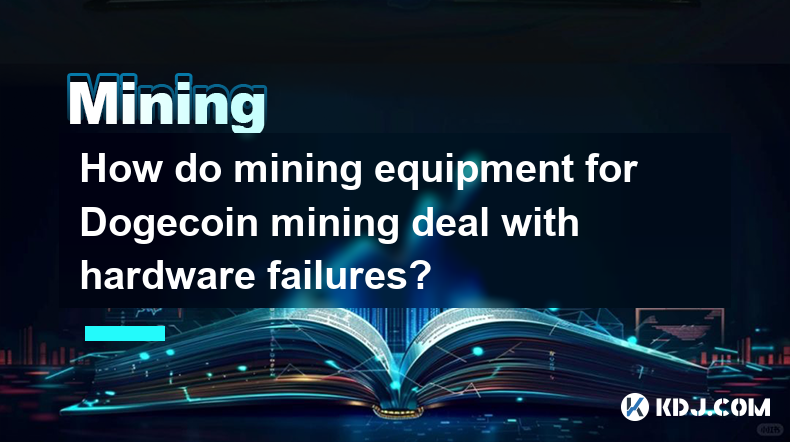
How do mining equipment for Dogecoin mining deal with hardware failures?
Apr 03,2025 at 09:15am
Dogecoin mining, like other forms of cryptocurrency mining, relies heavily on specialized hardware to perform the necessary computations to mine new coins. However, as with any technology, mining equipment can encounter hardware failures. This article will explore how mining equipment for Dogecoin mining deals with such failures, covering various aspect...
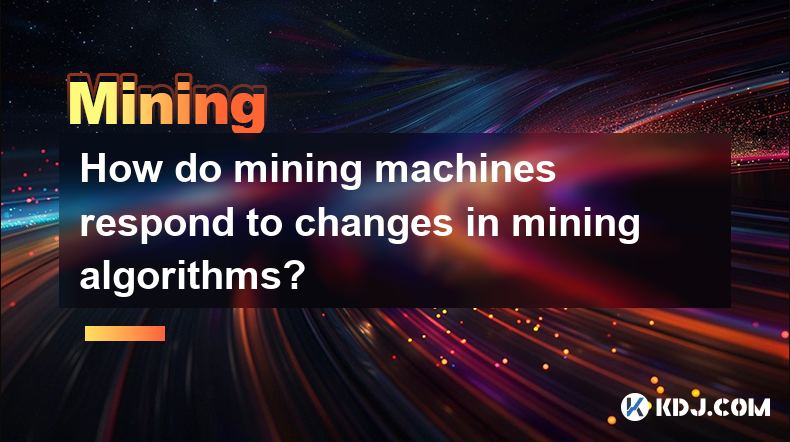
How do mining machines respond to changes in mining algorithms?
Apr 03,2025 at 07:07am
Mining machines are essential components of the cryptocurrency ecosystem, particularly for Proof of Work (PoW) blockchains like Bitcoin. These machines are designed to solve complex mathematical problems to validate transactions and add them to the blockchain. However, the algorithms that govern these mining processes can change, impacting the efficienc...
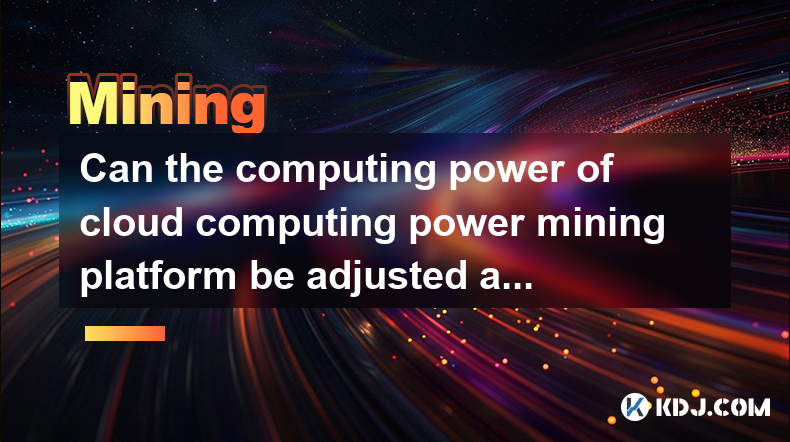
Can the computing power of cloud computing power mining platform be adjusted at any time?
Apr 03,2025 at 07:28am
Introduction to Cloud Computing Power Mining PlatformsCloud computing power mining platforms have revolutionized the way individuals and organizations participate in cryptocurrency mining. These platforms allow users to rent computing power from a pool of resources, enabling them to mine cryptocurrencies without the need for expensive hardware. A common...

How to balance mining income with graphics card power consumption?
Apr 03,2025 at 09:57am
Balancing mining income with graphics card power consumption is a critical consideration for cryptocurrency miners. The profitability of mining depends not only on the revenue generated from mining but also on the costs associated with running the mining equipment. Graphics cards, which are commonly used for mining, consume significant amounts of electr...
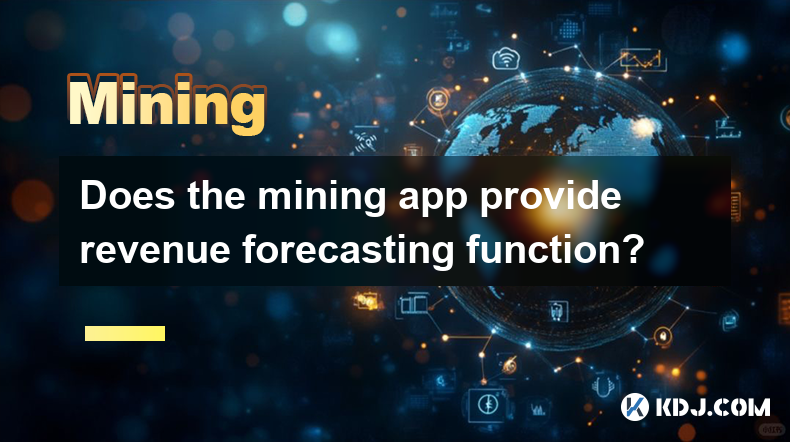
Does the mining app provide revenue forecasting function?
Apr 03,2025 at 07:22am
In the world of cryptocurrency, mining apps have become essential tools for miners looking to maximize their profits. One key feature that many miners seek in these apps is a revenue forecasting function. This article will explore whether mining apps provide such a function, how it works, and what benefits it offers to users. What is a Revenue Forecast...
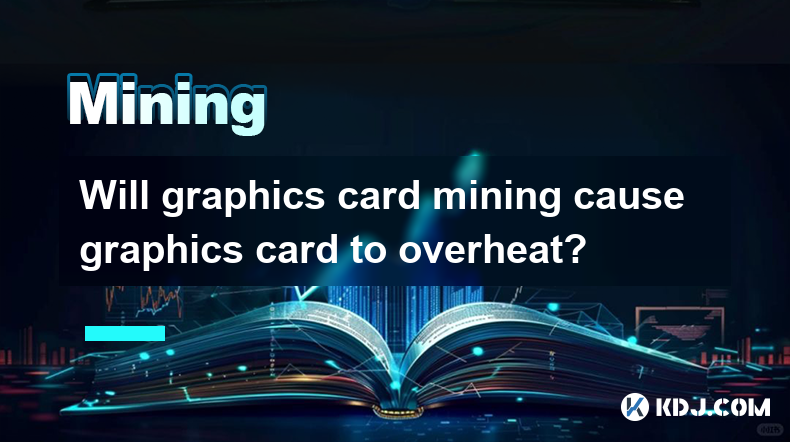
Will graphics card mining cause graphics card to overheat?
Apr 03,2025 at 06:49am
Mining cryptocurrencies with graphics cards has become increasingly popular, but it raises concerns about the potential for overheating. Graphics cards are designed to handle high-performance tasks, but continuous mining can push them to their limits. The heat generated during mining can affect the card's performance and longevity. Understanding the fac...

How do mining equipment for Dogecoin mining deal with hardware failures?
Apr 03,2025 at 09:15am
Dogecoin mining, like other forms of cryptocurrency mining, relies heavily on specialized hardware to perform the necessary computations to mine new coins. However, as with any technology, mining equipment can encounter hardware failures. This article will explore how mining equipment for Dogecoin mining deals with such failures, covering various aspect...

How do mining machines respond to changes in mining algorithms?
Apr 03,2025 at 07:07am
Mining machines are essential components of the cryptocurrency ecosystem, particularly for Proof of Work (PoW) blockchains like Bitcoin. These machines are designed to solve complex mathematical problems to validate transactions and add them to the blockchain. However, the algorithms that govern these mining processes can change, impacting the efficienc...

Can the computing power of cloud computing power mining platform be adjusted at any time?
Apr 03,2025 at 07:28am
Introduction to Cloud Computing Power Mining PlatformsCloud computing power mining platforms have revolutionized the way individuals and organizations participate in cryptocurrency mining. These platforms allow users to rent computing power from a pool of resources, enabling them to mine cryptocurrencies without the need for expensive hardware. A common...

How to balance mining income with graphics card power consumption?
Apr 03,2025 at 09:57am
Balancing mining income with graphics card power consumption is a critical consideration for cryptocurrency miners. The profitability of mining depends not only on the revenue generated from mining but also on the costs associated with running the mining equipment. Graphics cards, which are commonly used for mining, consume significant amounts of electr...

Does the mining app provide revenue forecasting function?
Apr 03,2025 at 07:22am
In the world of cryptocurrency, mining apps have become essential tools for miners looking to maximize their profits. One key feature that many miners seek in these apps is a revenue forecasting function. This article will explore whether mining apps provide such a function, how it works, and what benefits it offers to users. What is a Revenue Forecast...

Will graphics card mining cause graphics card to overheat?
Apr 03,2025 at 06:49am
Mining cryptocurrencies with graphics cards has become increasingly popular, but it raises concerns about the potential for overheating. Graphics cards are designed to handle high-performance tasks, but continuous mining can push them to their limits. The heat generated during mining can affect the card's performance and longevity. Understanding the fac...
See all articles
























































































